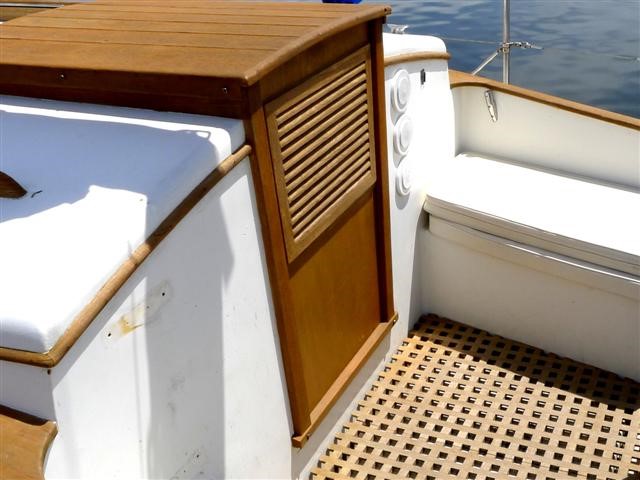
Teak Care
Love teak?
Here's an article by Don Casey on keeping things looking good.
In clean air untreated teak weathers to an attractive ash gray, but where most boats live, the assault of modern-day air pollutants quickly turns bare teak nearly black. Scrubbing tends to leave behind an unattractive mottled look, neither golden nor gray. Most boat owners eventually find themselves unhappy with either look and decide that some treatment is essential.
If we want the natural beauty of the wood to show, we must apply a clear coating.
Cleaning
Before teak can be given any coating, it must be completely clean. Your expensive teak is literally dissolved by strong cleaners, so always use the mildest cleaner that does the job. A 75/25 mixture of liquid laundry detergent (such as Wisk) and chlorine bleach may be adequate, perhaps boosted with TSP (trisodium phosphate). Apply this mixture with a stiff brush, scrubbing lightly with the grain. Leave it on the wood for several minutes to give the detergent time to suspend the dirt and the bleach time to lighten the wood, then rinse the wood thoroughly, brushing it to clear the grain.
If the teak is still dark or stained when it dries, a cleaner with oxalic acid is required. This is the active ingredient in most single-part teak cleaners. Wet the teak and sprinkle on the cleaner. Spread it evenly with a Scotchbrite or bronze wool pad, then give it a few minutes to work. While the wood is still wet, scrub it with the Scotchbrite pad or bronze wool. (Never, ever, ever use steel wool aboard your boat--it will leave a trail of rust freckles that will be impossible to remove.) Oxalic acid will dull paint and fiberglass and damage anodized aluminum, so wet down surrounding surfaces before you start and keep them free of the cleaner. Rinse the scrubbed wood thoroughly--brushing is required--and let it dry completely.
Two-part teak cleaners are dramatically effective at restoring the color to soiled, stained, and neglected teak, but these formulations contain a strong acid--usually hydrochloric--and should only be used when gentler cleaning methods have failed. Wet the wood to be cleaned. The cleaner will dissolve natural bristles, so use a nylon brush to paint part one onto the wet wood. Avoid getting the cleaner onto adjoining surfaces. Remove the dissolved surface by scrubbing the wood with the grain with a stiff brush or a Scotchbrite pad.
Part two neutralizes the acid in part one, and it usually has some additional cleaning properties. Paint a sufficient amount of part two onto the teak to get a uniform color change, then scrub lightly. Flush away all traces of the cleaner and let the wood dry.
Oiling
Oiling teak on boats is a time-honored tradition. Oil intensifies the colors and grain patterns of wood and gives the wood a rich, warm appearance. Because it simply enhances the inherent beauty of the wood--more like salt than sauce--oiling is arguably the most attractive of all wood finishes, and it restores some of the teak's natural oils and resins. Unfortunately, the benefit of oiling exterior teak is extremely transitory. The sorry truth is that teak will last just as long if you don't oil it--longer really, since repeated between-coat scrubbing wears the wood away. But oiling teak isn't about protecting the wood; it's about recovering and maintaining that golden glow that made us want teak on the boat in the first place.
Teak oils are primarily either linseed oil or tung oil, bolstered by resins to make them more durable. Linseed oil tends to darken the teak, but it is significantly cheaper. Tung oil doesn't darken the wood, and it is more water resistant than linseed oil--a notable advantage for boat use. However, a month or two after application, it may be hard to discern that much difference since both oils carbonize in the sun and turn dark. Proprietary teak oils address this problem with various additives, including pigments, UV filters, and mildew retardants. Some that perform admirably in one climate are reviled in another. If you are going to oil your teak, make your teak oil selection based on the recommendations of other boatowners in your area.
Apply teak oil with a paint brush. Immediately wipe up (with a spirits-dampened cloth) any drips or runs on fiberglass or painted surfaces, or the resins the oil contains will leave dark, nearly-impossible-to-remove stains. Watch out for sneaky runs below the rail.
Oiling requires multiple coats. The wood will initially "drink" the oil, and thinning the first coat about 20% with mineral spirits or turpentine encourages it to penetrate the wood more deeply. By the third coat, oil will begin to stand in some areas. Wipe up excess oil with a cloth. Continue to brush on the oil and wipe away any excess until the wood is saturated. The wood should have a matte finish without any shiny spots.